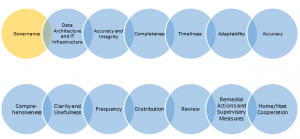
Principle 1:
Governance – A bank’s risk data aggregation capabilities and risk reporting practices should be subject to strong governance arrangements consistent with other principles and guidance established by the Basel Committee.
My colleagues and I have written a series of posts on the principles of BCBS 239. In this post, I’ll focus on the requirements of Principle 1 and describe how high-performance analytics can support you.
BCBS Principle 1 requires that a set of governance processes are created and that management oversees these processes at the executive level. However, before these can be effectively enforced, the data needed to aggregate and report on regulatory compliance must be accurate and trustworthy. The goal of this principle is to hold executives beyond the CRO and across all lines of business accountable for a sustainable framework that will not only meet regulatory obligations but strengthen risk strategy and oversight.
The Basel Committee’s Working Group on SIB Supervision developed a questionnaire to identify the progress (or lack thereof) that global systemically important banks (G-SIBs) are making to meet the January 2016 BCBS 239 compliance deadline.
The results of the “self-assessment’ - completed in 2013 - indicated that although 83 percent of all G-SIBs rated themselves as “largely compliant,” 17 percent thought their organizations were “materially non-compliant.” Sadly, none considered themselves fully compliant.
Overcoming the barriers to compliance
Data governance requires measurement and continuous improvement of data quality, which presents a need for clear roles and responsibilities. Many banks are struggling with defining and unifying the taxonomies of their risk data repositories, as well as establishing clear risk data ownership. The bank’s board of directors is now required to oversee and approve the corporate risk policies since risk management has so many strategic implications. A well-governed, risk aware financial institution must ensure the risk infrastructure can deliver quality data, produce accurate regulatory reports, and monitor and manage risks near real-time.
BCBS 239 affects not only technology and software architecture but also affects the organization and procedures of data management and risk reporting of the bank, basically calling for a governance framework. SAS risk management solutions assist you in doing just this.
True data quality can only be achieved when there is proper interaction between IT and business departments. Data visualizations, for example, can help make risk-related data immediately understandable for the board of directors, allowing them to take risk insights into account for strategic decision making.
With SAS, banks can process large data volumes and complex real-time risk measures using data quality dashboards and data quality measures.
- SAS® Data Management provides the underlying infrastructure for data access, data integration, data quality and data governance.
- SAS high-performance analytics supports the parallelization of processes using grid computing and in-memory analytics.
- SAS® High-Performance Risk can be used to retrieve key risk results within a short time window so management can make better decisions to deliver better business outcomes.
- SAS® Visual Analytics can provide the executives governing the BCBS 239 principles with easy-to-use dashboards and reports.
In the next post, Samuel Munoz will discuss the requirements in Principle 2 - Data architecture and IT infrastructure. In the meantime, learn more about how SAS can help you address BCBS 239 compliance.
